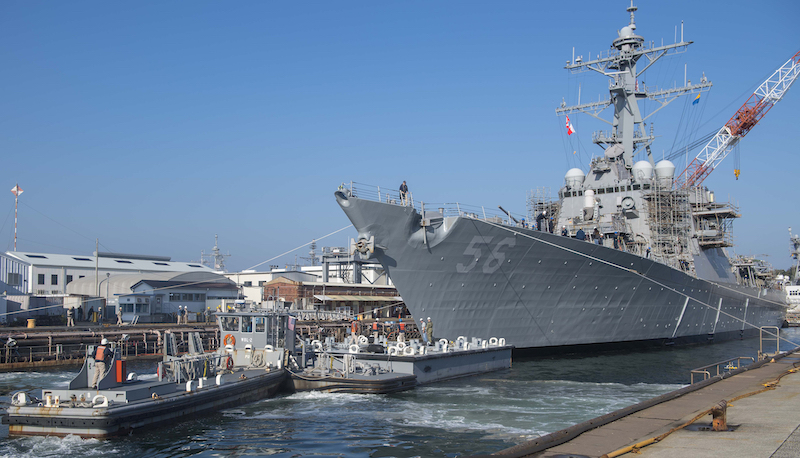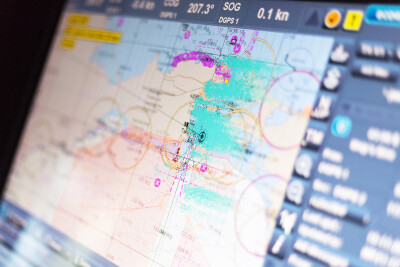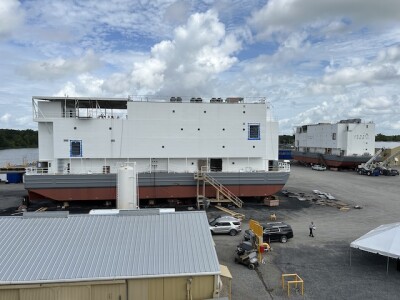The National Transportation Safety Board (NTSB) has issued a marine accident report (MAR) of its investigation of the fatal 2017 collision between the Navy destroyer John S McCain and tanker Alnic MC in the Singapore Strait. The NTSB cited lack of operational oversight by the Navy as the cause.
On Aug. 21, 2017, the 504.5'x66.4' McCain was overtaking the 600.4'x105.6' Liberian-flagged tanker Alnic MC while both vessels were transiting the westbound lane in the Middle Channel passage of the Singapore Strait Traffic Separation Scheme, the NTSB report said. The destroyer crew had a perceived loss of steering, and, while the crew attempted to regain control of the vessel, the John S McCain unintentionally turned to port into the path of the Alnic MC, the Marine Accident Report NTSB/MAR-19/01 said. At 0524, the vessels collided.
As a result of the collision, 10 sailors aboard the McCain died, 48 were injured, and the vessel sustained over $100 million in damage. No one was injured on the Alnic MC. The tanker sustained about $225,000 in damage.
The NTSB determined that the probable cause of the collision between the destroyer and the tanker was a lack of effective operational oversight of the destroyer by the U.S. Navy, which resulted in insufficient training and inadequate bridge operating procedures. Contributing to the accident were the John S McCain bridge team’s loss of situation awareness and failure to follow loss of steering emergency procedures, which included the requirement to inform nearby traffic of their perceived loss of steering, the NTSB said. Also contributing to the accident was the operation of the steering system in backup manual mode, which allowed for an unintentional, unilateral transfer of steering control.
Safety issues identified in this accident by the NTSB include:
• The decision to transfer the location of thrust control on board the John S McCain while the vessel was in a congested waterway
• The lack of very high frequency radio communications between the vessels
• The automatic identification system (AIS) data transmission policy for Navy vessels
• The procedures for the transfers of steering and thrust control on board the John S McCain
• The training of Navy bridge watchstanders
• The design of the destroyer’s Integrated Bridge and Navigation System
• Navy watchstanders’ fatigue
• Navy oversight of the John S McCain
As a result of its investigation, the NTSB has issued the following safety recommendations to the Navy:
- Issue permanent guidance directing destroyers equipped with the Integrated Bridge and Navigation System to operate in computer-assisted steering modes, except during an emergency. (M-19-8)
- Issue guidance to your ships’ crews emphasizing the importance of the appropriate use of very high frequency radio for safe navigation. (M-19-9)
- Ensure that the modernization of complex systems, such as steering and control systems within the Integrated Bridge and Navigation System, incorporates the design principles set forth in ASTM International Standard F1166, Standard Practice for Human Engineering Design for Marine Systems, Equipment, and Facilities. (M-19-10)
- Revise written instructions for bridge watchstanders on destroyers equipped with the Integrated Bridge and Navigation System to include operating procedures for shifting steering and thrust control between all bridge stations. (M-19-11)
- Revise Integrated Bridge and Navigation System (IBNS) technical manuals to include a description of and procedures for ganging and unganging throttles, and ensure that revised technical manuals are distributed to IBNS-equipped ships. (M-19-12)
- Revise the training standards for helmsman, lee helmsman, and boatswain’s mate of the watch for destroyers equipped with the Integrated Bridge and Navigation System to require demonstrated proficiency in all system functions, including the transfer of steering and thrust control between all bridge control stations. (M-19-13)
- Institute Seafarers’ Training, Certification and Watchkeeping Code rest standards for all crewmembers aboard your vessels. (M-19-14)





